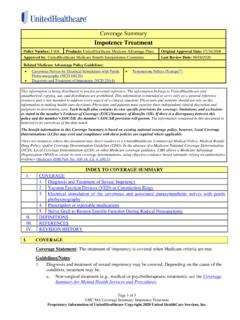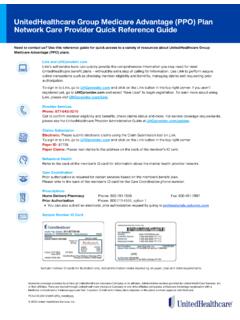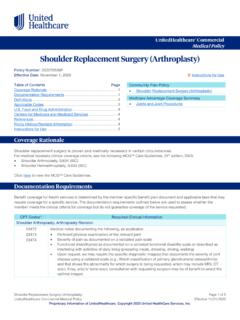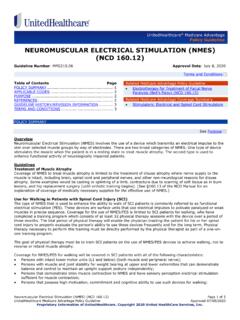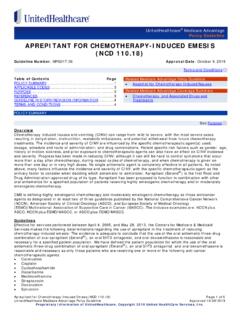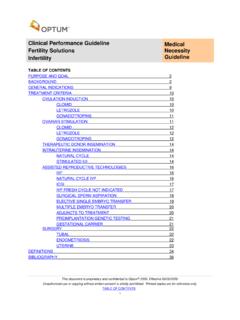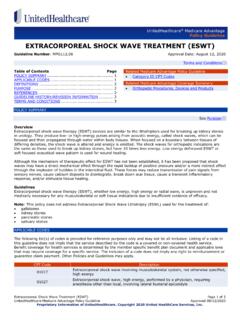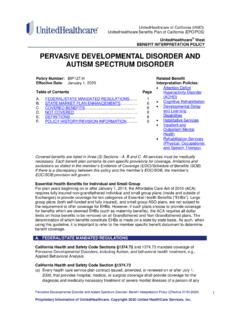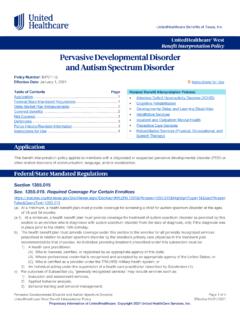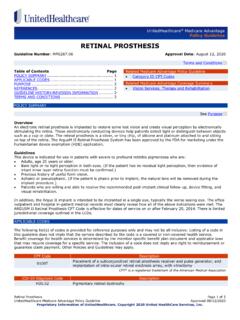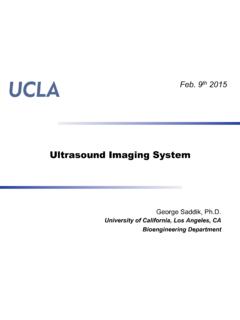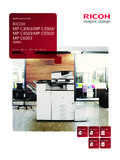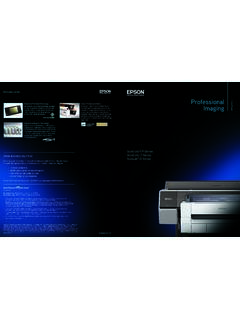Transcription of Breast Imaging for Screening and Diagnosing Cancer ...
1 Breast Imaging for Screening and Diagnosing Cancer Page 1 of 14 UnitedHealthcare Commercial Medical Policy Effective 01/01/2022 Proprietary Information of UnitedHealthcare. Copyright 2022 United HealthCare Services, Inc. UnitedHealthcare Commercial Medica l Policy Breast Imaging for Screening and Diagnosing Cancer Policy Number: 2022T0375BB Effective Date: January 1, 2022 Instructions for Use Table of Contents Page Coverage Rationale .. 1 Documentation Requirements .. 2 Definitions .. 2 Applicable Codes .. 3 Description of Services .. 5 Clinical Evidence .. 5 Food and Drug Administration .. 11 References .. 12 Policy History/Revision Information.
2 13 Instructions for Use .. 14 Coverage Rationale Note: This policy does not address preventive benefit for Breast Cancer Screening (including mammography); refer to the Coverage Determination Guideline titled Preventive Care Services for more information. The following are proven and medically necessary for the following individuals: Digital mammography for individuals with dense Breast tissue Diagnostic Breast ultrasound Breast magnetic resonance Imaging (MRI) for individuals who are high risk for Breast Cancer as defined as having any of the following: o Prior thoracic radiation therapy between the ages 10 and 30 o Lifetime risk estimated at greater than or equal to 20% as defined by models that are largely dependent on family history ( , Gail, Claus, Tyrer-Cuzick or BRCAPRO) o Personal history of Breast Cancer (not treated with bilateral mastectomy) o Personal history with any of the following: Li-Fraumeni Syndrome (TP53 mutation) Confirmed BRCA 1 or BRCA 2 gene mutations Peutz-Jehgers Syndrome (STK11, LKB1 gene variations) PTEN gene mutation o Family history with any of the following.
3 At least one first-degree relative who has a BRCA1 or BRCA2 mutation First-degree relative who carries a genetic mutation in the TP53 or PTEN genes (Li-Fraumeni syndrome and Cowden and Bannayan-Riley-Ruvalcaba syndromes, or Peutz-Jehgers Syndrome) At least two first-degree relatives with Breast or ovarian Cancer One first-degree relative with bilateral Breast Cancer , or both Breast and ovarian Cancer First or second-degree male relative (father, brother, uncle, grandfather) diagnosed with Breast Cancer The following are unproven and not medically necessary due to insufficient evidence of efficacy: Automated Breast ultrasound system Related Commercial Policies Magnetic Resonance Imaging (MRI) and Computed Tomography (CT) Scan Site of Service Omnibus Codes Preventive Care Services Community Plan Policy Breast Imaging for Screening and Diagnosing Cancer Breast Imaging for Screening and Diagnosing Cancer Page 2 of 14 UnitedHealthcare Commercial Medical Policy Effective 01/01/2022 Proprietary Information of UnitedHealthcare.
4 Copyright 2022 United HealthCare Services, Inc. Breast magnetic resonance Imaging (MRI) for individuals with dense Breast tissue not accompanied by defined risk factors as described above Computer-aided detection (CAD) Computer-aided tactile Breast Imaging Computed tomography (CT) of the Breast Electrical impedance scanning (EIS) Magnetic resonance elastography (MRE) Molecular Breast Imaging ( , Breast Specific Gamma Imaging , Scintimammography, positron emission mammography) Note: For Breast computed tomography (CT) and 3D rendering of the Breast , or additional indications for Breast MRI, refer to the Cardiology and Radiology Imaging Guidelines Breast Imaging Guidelines.
5 Documentation Requirements Benefit coverage for health services is determined by the member specific benefit plan document and applicable laws that may require coverage for a specific service. The documentation requirements outlined below are used to assess whether the member meets the clinical criteria for coverage but do not guarantee coverage of the service requested. CPT Codes* Required Clinical Information Breast Imaging for Screening and Diagnosing Cancer 0633T, 0634T, 0635T, 0636T, 0637T, 0638T, 76376, 76377, 76498, 77046, 77047, 77048, 77049 Provider should call the number on the member s ID card when referring for radiology services.
6 Medical notes documenting the following, when applicable: Recent history and physical Documentation to support medical necessity ( , family history, prior treatment, genetic testing results, other Imaging studies and diagnostic results, etc.) Applicable CPT code *For code descriptions, see the Applicable Codes section. Definitions Automated Breast Ultrasound (ABUS): Automated Breast Ultrasound is the first and only ultrasound system developed and US Food and Drug Administration (FDA) approved specifically for Breast Cancer Screening in women with dense Breast tissue who have not had previous Breast biopsies or surgeries. ABUS systems are ultrasound Imaging platforms that use high-frequency broadband transducers to automate the acquisition of volume data to provide two-dimensional (2D) and three-dimensional (3D) B-mode images of Breast tissue.
7 It is used as an adjunct to mammography. The high center-frequency significantly sharpens detail resolution while the ultra-broadband performance simultaneously delivers distinct contrast differentiation. (ACS, 2016) Breast Specific Gamma Imaging (BSGI): BSGI, also known as scintimammography (SMM) or molecular Breast Imaging (MBI) is a noninvasive diagnostic technology that detects tissues within the Breast that accumulate higher levels of a radioactive tracer that emit gamma radiation. The test is performed with a gamma camera after intravenous administration of radioactive tracers. Scintimammography has been proposed primarily as an adjunct to mammography and physical examination to improve selection for biopsy in patients who have palpable masses or suspicious mammograms.
8 (ACS, 2016) Breast Ultrasound: Ultrasound, also known as sonography, is an Imaging method using sound waves rather than ionizing radiation to a part of the body. For this test, a small, microphone-like instrument called a transducer is placed on the skin (which is often first lubricated with ultrasound gel). It emits sound waves and picks up the echoes as they bounce off body tissues. The echoes are converted by a computer into a black and white image on a computer screen. Ultrasound is useful for evaluating some Breast masses and is the only way to tell if a suspicious area is a cyst (fluid-filled sac) without placing a needle into it to aspirate (draw out) fluid.
9 Cysts cannot accurately be diagnosed by physical exam alone. Breast ultrasound may also be used to help doctors guide a biopsy needle into some Breast lesions. (ACS, 2016) Breast Imaging for Screening and Diagnosing Cancer Page 3 of 14 UnitedHealthcare Commercial Medical Policy Effective 01/01/2022 Proprietary Information of UnitedHealthcare. Copyright 2022 United HealthCare Services, Inc. Computer-Aided Detection (CAD) for Ultrasound: CAD systems for ultrasound use pattern recognition methods to help radiologists analyze images and automate the reporting process. These systems have been developed to promote standardized Breast ultrasound reporting.
10 (ACS, 2016) Computer-Aided Detection (CAD) with MRI of the Breast : Computer-aided detection has been used to aid radiologists interpretation of contrast-enhanced MRI of the Breast , which is sometimes used as an alternative to mammography or other Screening and diagnostic tests because of its high sensitivity in detecting Breast lesions, even among those in whom mammography is less accurate ( , younger women and those with denser breasts). (ACS, 2016) Computer-Aided Tactile Breast Imaging : Tactile Breast Imaging includes placing a tactile array sensor in contact with the Breast . As the clinician gently moves the hand-held sensor across the Breast and underarm area, data signals are then processed into multi-dimensional color images that instantly appear on a computer screen in real-time, allowing the clinician to view the size, shape, hardness and location of suspicious masses immediately.
